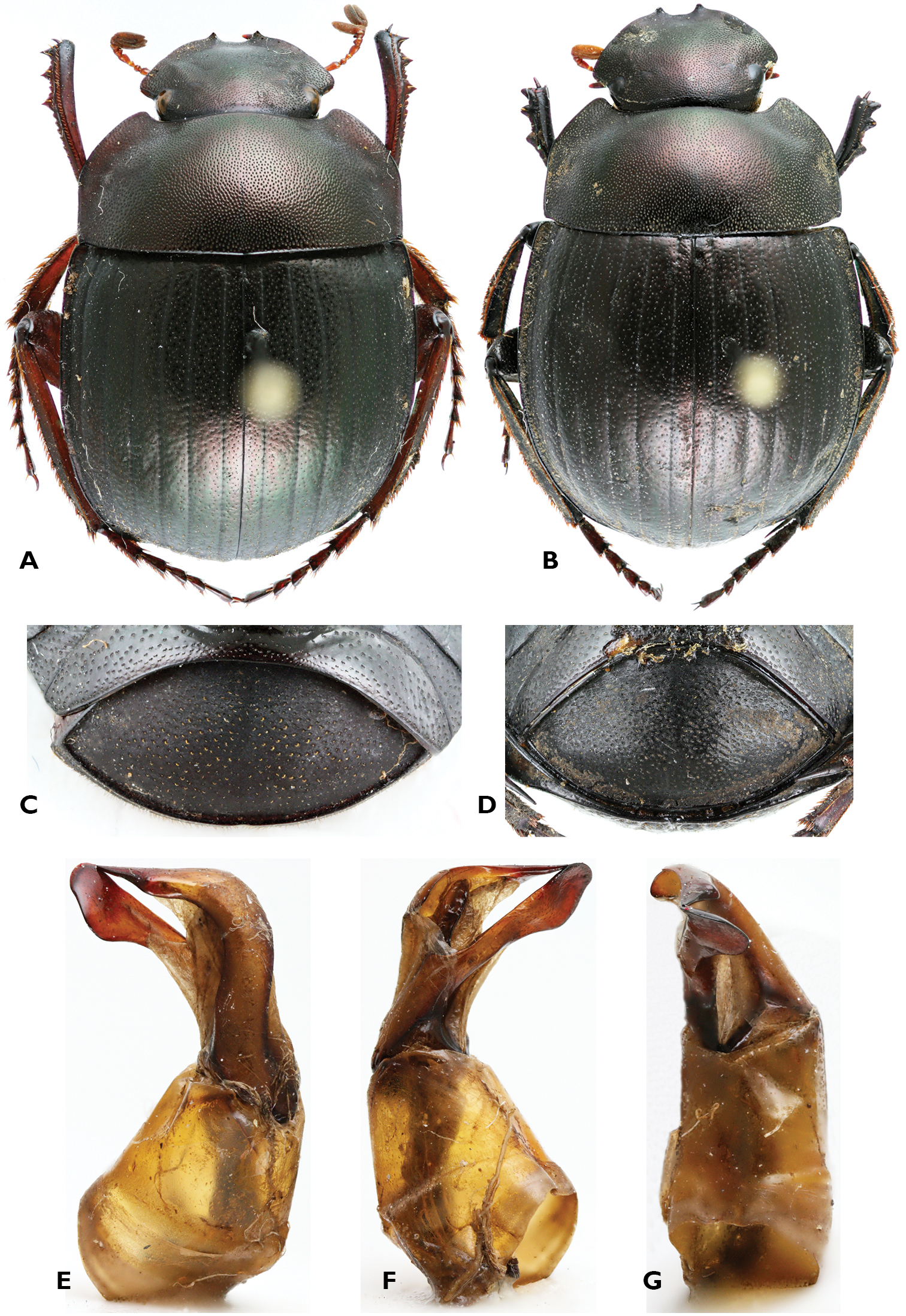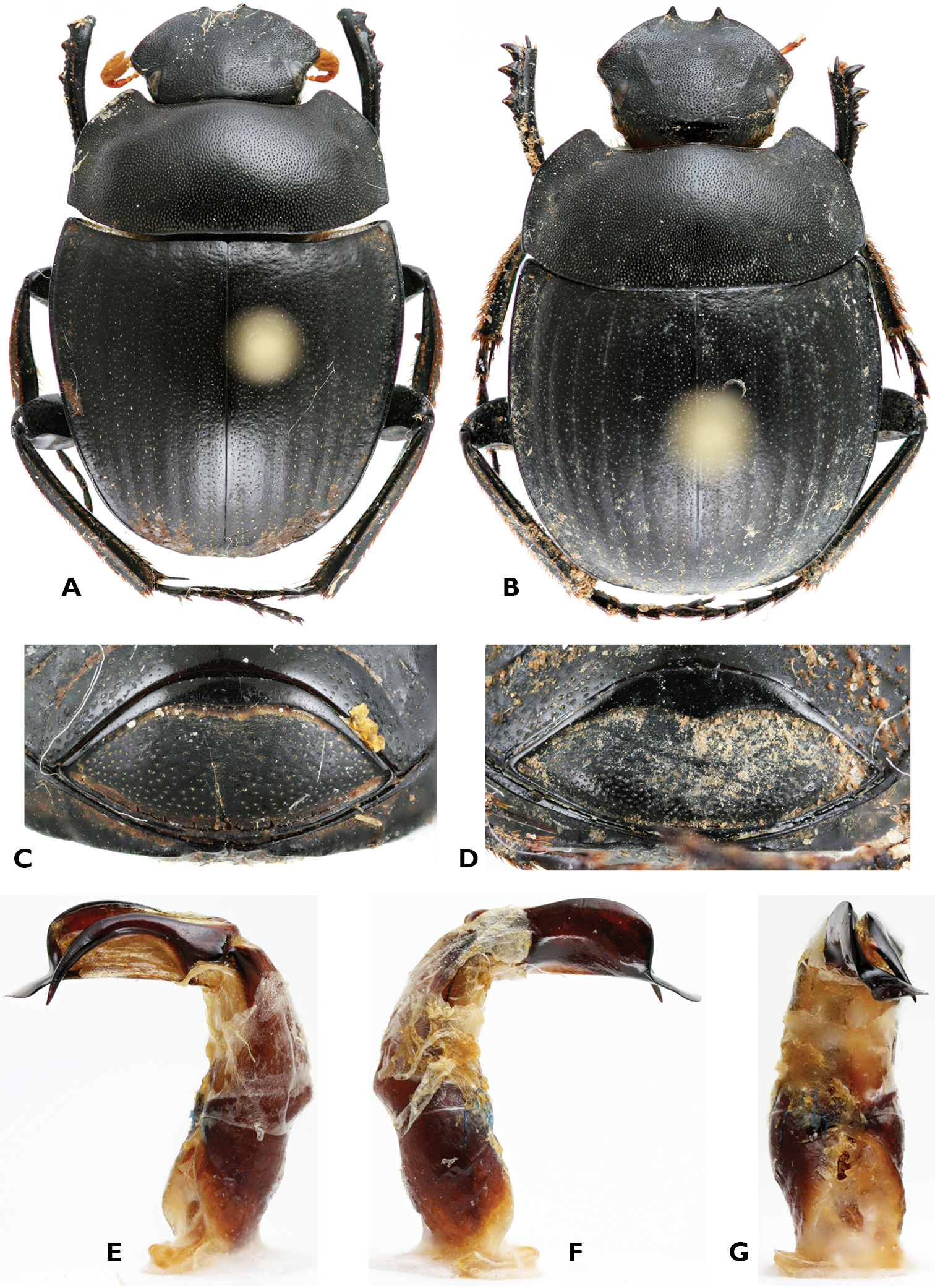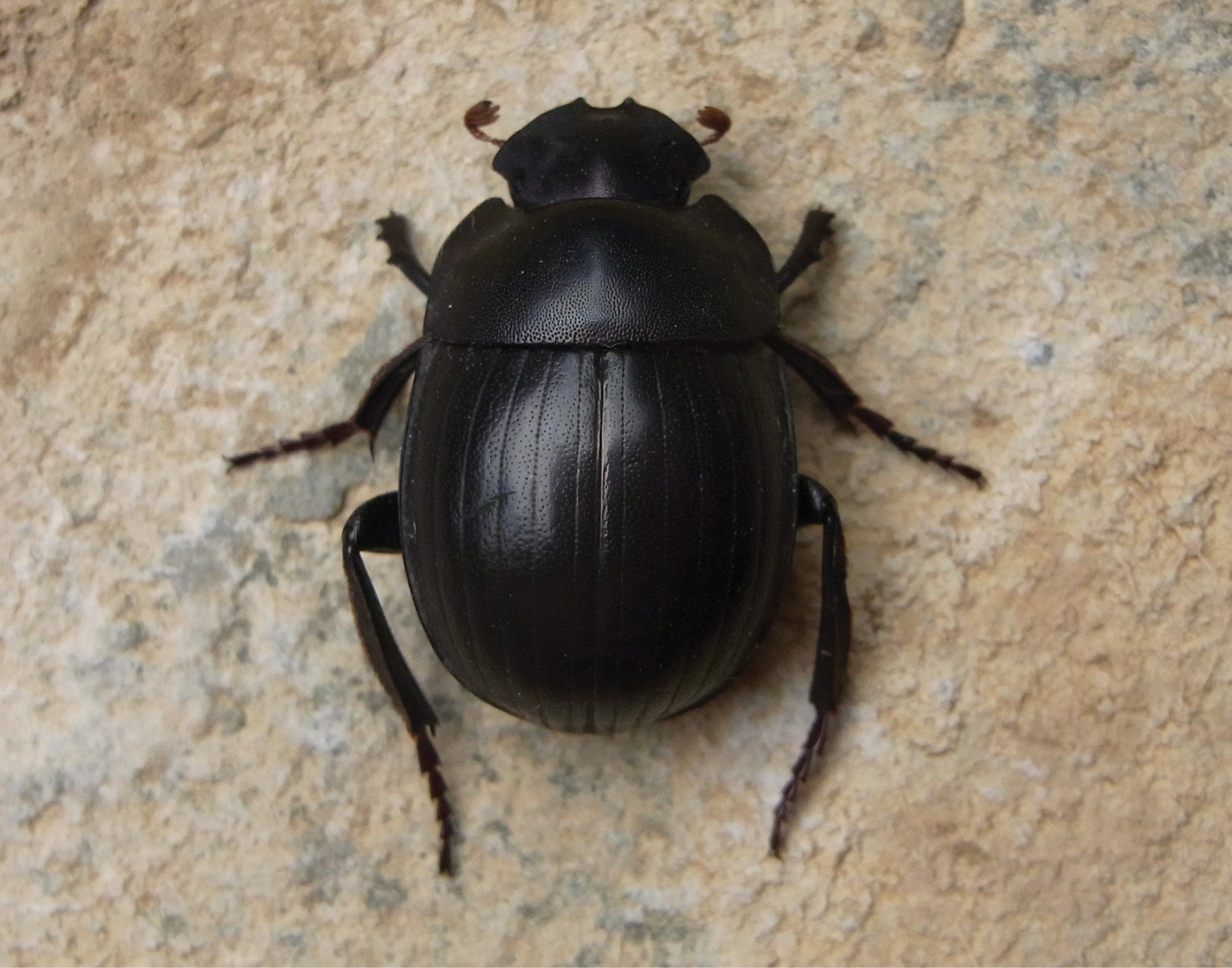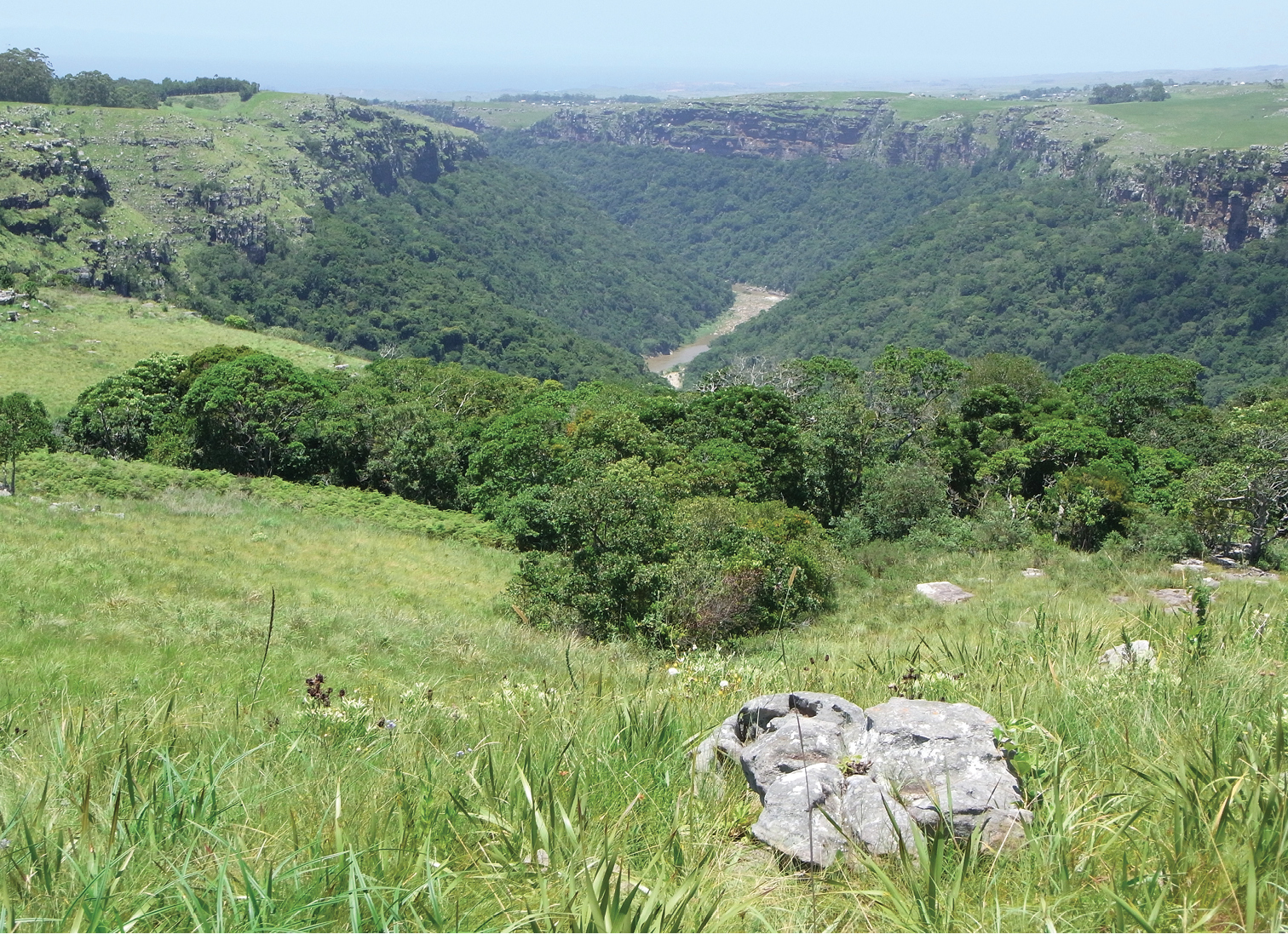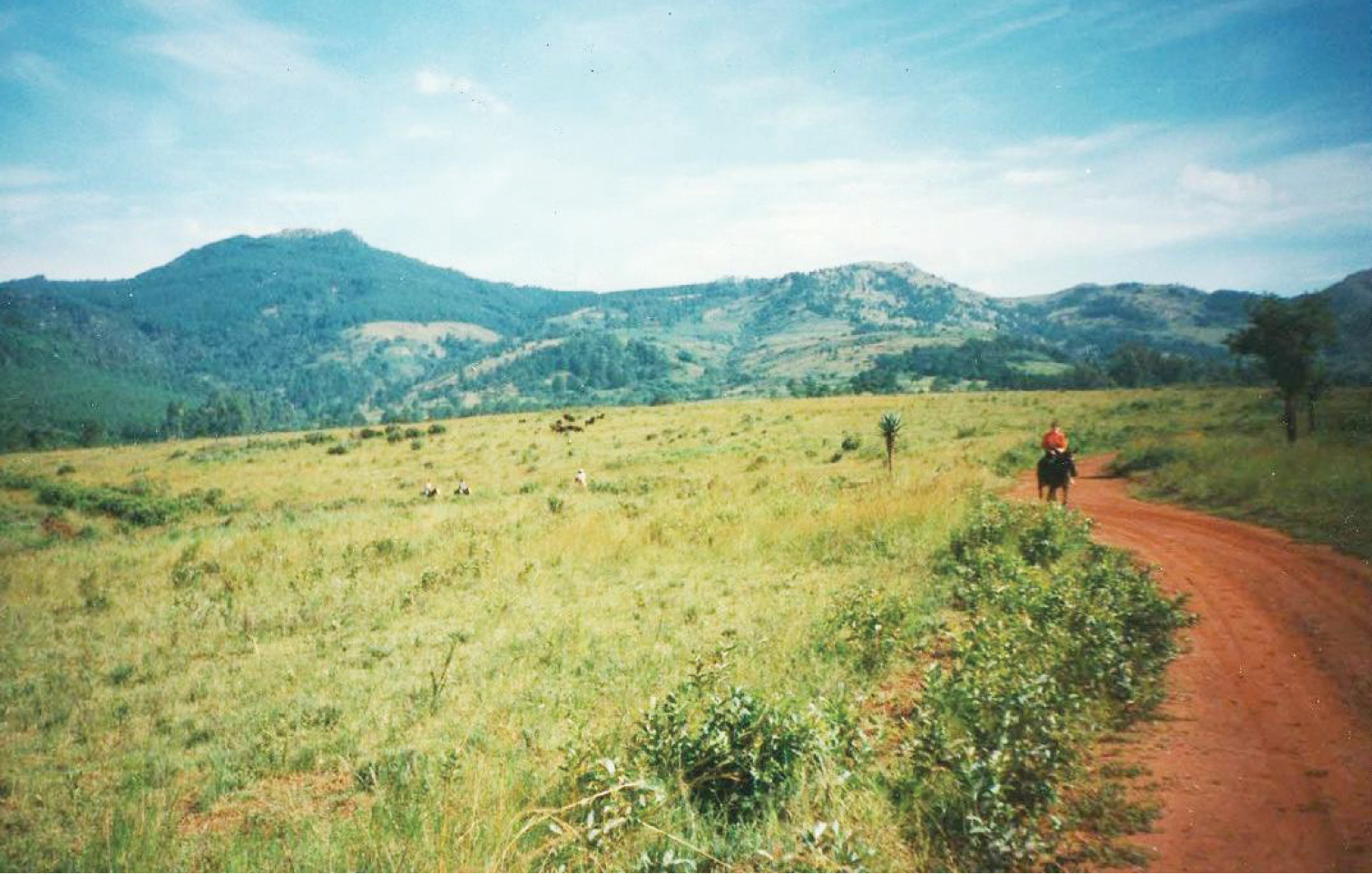






(C) 2013 Philippe Moretto. This is an open access article distributed under the terms of the Creative Commons Attribution License 3.0 (CC-BY), which permits unrestricted use, distribution, and reproduction in any medium, provided the original author and source are credited.
For reference, use of the paginated PDF or printed version of this article is recommended.
Citation: Moretto P, Perissinotto R (2013) Description and ecology of two new species of Gyronotus van Lansberge, 1874 (Coleoptera, Scarabaeidae) from southern Africa. ZooKeys 344: 73–82. doi: 10.3897/zookeys.344.6101
Recent collections in KwaZulu-Natal and Swaziland have led to the discovery of two new species of the flightless and highly threatened Scarabaeinae genus Gyronotus van Lansberge, 1874. A description of G. perissinottoi sp. n. and G. schuelei sp. n. is provided here, along with notes on their habitat and ecology. Unlike the vast majority of the species previously known in the genus, which have been reported as forest dwellers, the two new species are found during daytime in grassland/savanna vegetation, at the margin of forest patches.
Scarabaeinae, new species, threatened genus, South Africa, Swaziland, montane grassland, sour bushveld, coastal sourveld
The genus Gyronotus currently includes six species, subdivided into three species groups on the basis of their biogeographic distribution, body shape and structure of male genitalia (
On the basis of the wide gaps existing between the distribution ranges of the species currently described,
As part of the collecting efforts, ground traps baited with fresh baboon dung were deployed in the Umthamvuna Reserve during December 2012 and January 2013. Traps consisted of 600 ml plastic jars of 80 mm mouth diameter and 120 mm height buried in the soil with the top levelled with the ground. They were checked at regular intervals of 2–5 days and after each visit traps were first emptied and then re-supplied with fresh dung.
The description of morphological characters follows the terminology used by
Collections are abbreviated as follows: TMSA, Ditsong National Museum of Natural History (formerly Transvaal Museum), Pretoria, South Africa; ISAM, Iziko South African Museum, Cape Town, South Africa; PMOC, Collection Philippe Moretto, Toulon, France; PCRP, Private Collection R. Perissinotto & L. Clennell, Port Elizabeth, South Africa. Geographical abbreviations are as follows: KZN, KwaZulu-Natal Province, South Africa; SWA, Swaziland.
http://zoobank.org/652366C0-B9E4-4526-B217-BB757A0EB0CF
http://species-id.net/wiki/Gyronotus_perissinottoi
Figures 1, 3South Africa, KwaZulu-Natal, Umthamvuna Nature Reserve, Beacon Hill Section (31°00'47"S, 30°10'23"E); on escarpment at the edge of riverine forest, in grassland interspersed with rocky outcrops and boulders.
Holotype ♂: South Africa, KZN, Umthamvuna Reserve, 13.I.2013, ground trap baited with baboon dung, R Perissinotto & L Clennell legit (TMSA). Allotype ♀: same data as above (TMSA). Paratypes, 3♂ 4♀: same data as above (ISAM, PCPR, PMOC). 1 ♀, same locality and collectors, but 24.I.2004 (PMOC); 1 ♀, same locality and collectors, but 28.I.2007 (PMOC).
Gyronotus perissinottoi sp. n. is, with Gyronotus dispar Felsche, 1911, one of the largest Gyronotus species currently known. In contrast to all the other species, including Gyronotus marginatus Péringuey, 1888, currently synonymized with Gyronotus pumilus (Boheman, 1857), the elytra are punctate and the interstriae very marked. Another typical character is the brush of long, flat-laying, yellow setae that cover a narrow area along the middle of the posterior side of the mesofemora in the male. The shape of the parameres is also unique, and closest to that of Gyronotus pumilus (sensu
This species is named after Renzo Perissinotto, who collected the entire type series and compiled the ecological notes reported in this work.
Length 16–18 mm, width 9–10.5 mm; body convex, rounded, shining bronze with metallic reflections, glabrous on the upper side; with few inconspicuous setae on the posterior quarter of elytra in very fresh specimens.
Head. Entirely, densely and finely punctate, except the anterior part of the clypeus which is sparsely and very finely dotted; clypeo-genal suture faint; only short segment of occipital suture present on each side of the head, reaching the extremity of the clypeo-genal suture.
Thorax. Entirely, densely and finely punctate, with punctures finer anteriorly and larger laterally. Lateral angle at middle of sides widely rounded; mesosternum strongly punctate near the suture and in the middle, but finely punctate laterally; metasternum shiny and very finely punctate in the middle part, shagreened and more strongly punctate laterally, with punctures elongated; internal end of male protibia broadened, densely fringed at apex with very short setae, mobile spur short and directed obliquely outwards; female protibia with sharp tooth at the apex of the inner border, mobile spur about twice as long as in the male and directed forward; femora densely punctate; brush of long, flat-laying, yellow setae covering a narrow area along the middle of the posterior side of the mesofemora in male (Figure 1A); brush of setae absent in female (Figure 1B).
Gyronotus perissinottoi sp. n. A Holotype male, dorsal habitus B Allotype female, dorsal habitus C Male pygidium, ventral side D Female pygidium, ventral side E left F right and G ventral sides of aedeagus. Photo: Mickaël François.
Elytra. Regularly and strongly convex dorsally, slightly convex laterally; striae obsolete, but densely and strongly punctate, visible with naked eye; interstriae slightly convex, sparsely and finely punctate, with punctures of different size on a very finely shagreened tegument, interspersed with very small, flat and shiny granules.
Abdomen. Sternites smooth, finely punctate medially, stronger laterally; pygidium convex, strongly shagreened, strongly and very densely punctate in females, but sparsely and finely with punctures elongated in males; parameres of aedeagus asymmetrical (Figures 1E–G).
It was previously known that Gyronotus pumilus also occurs in the Umthamvuna Nature Reserve (
http://zoobank.org/8C6B0DE7-D83F-42A3-A35F-FD5EB536A18C
http://species-id.net/wiki/Gyronotus_schuelei
Figures 2Western Swaziland (26°08'18"–26°29'33"S; 31°08'13"–31°11'02"E); in mountain grassland with pockets of sour bushveld.
Holotype ♂: Swaziland, Mlilwane, 28.III.1997, R. Perissinotto & L. Clennell legit (PMOC). Allotype ♀: 19/20.XI.2001, Swaziland, Malolotja Nature Reserve, P. Schüle legit (PMOC).
This species shows its closest affinity to Gyronotus glabrosus Scholtz & Howden, 1987 (p. 84, fig. 3), with which it shares the same structure of the parameres, although their shape is clearly different. In particular, the right paramere is much slender and more regularly curved than its left counterpart, while the apical plate of the left paramere is larger than that on the right.
This species is dedicated to Peter Schüle, German specialist of Cicindelidae, who collected the allotype specimen.
Length 14 mm, width 8.5 mm; body moderately convex, very dark brown, with few short, erected, white setae on the posterior half of the elytra.
Head. Entirely, densely and finely punctate except for a small space between the clypeal teeth, which is finely dotted.
Thorax. Entirely, densely and very finely punctate; exhibiting lateral angle before the middle of the sides; mesosternum strongly but sparsely punctate; metasternum shiny, very finely and sparsely punctate; profemur densely punctuate; mesofemur punctate in the middle, sparsely dotted distally and apically; metafemur sparsely dotted distally, densely punctuate apically.
Elytra. Striae obsolete on the disc, more distinct on the sides, finely punctate; interstriae flat on the disc, more convex apically and laterally, finely punctate.
Abdomen. Pygidium convex in male, totally inflexed in ventral position in female; with raising contour at margin, particularly enlarged at apex in male (Figure 2C), very enlarged in female (Figure 2D); parameres of aedeagus asymmetrical (Figures 2E–G).
Gyronotus schuelei sp. n. A Holotype male, dorsal habitus B Allotype female, dorsal habitus C Male pygidium, ventral side D Female pygidium, ventral side E left F right and G ventral sides of aedeagus. Photo: Mickaël François.
Gyronotus perissinottoi sp. n. in its natural habitat at the Umthamvuna Nature Reserve. Photo: Lynette Clennell.
This appears to be the first record of the presence of Gyronotus in Swaziland. Its distribution range needs to be investigated further, as it may include adjacent mountainous areas in the Mpumalanga Province of South Africa.
The genus Gyronotus is part of the tribe Canthonini, which has long been recognised as a Gondwanaland relict (
The two new species described here, Gyronotus perissinottoi sp. n. and Gyronotus schuelei sp. n., together with Gyronotus glabrosus, are actually grassland or savanna inhabitants. The first is found exclusively in open coastal sourveld with scattered shrubs and small trees, on the plateau and escarpment just above the scarp forest that characterise the Umthamvuna River Gorge, at altitudes of 300–400 m (Figures 3–4). According to the classification scheme of
Gyronotus perissinottoi sp. n. Typical habitat in the escarpment grassland at the margin of the riverine forest (Umthamvuna Nature Reserve, South Africa). Photo: Lynette Clennell.
The Mlilwane and Malolotja reserves of western Swaziland, where Gyronotus shuelei sp. n. has been recorded so far, are higher altitude (700–1500 m) hilly areas (Figure 5) that exhibit vegetation units of the KaNgwane montane grassland and Swaziland sour bushveld types, coded respectively Gm 16 and SVI 14 in
Gyronotus schuelei sp. n. Typical habitat in montane grassland interspersed with bushveld pockets (Mlilwane Nature Reserve, Swaziland). Photo: Lynette Clennell.
Concerning food exploitation, at Umthamvuna Gyronotus perissinottoi sp. n. appears to rely mainly on Chacma baboon (Papio hamadryas) dung, while Gyronotus pumilus inside the forest is regularly observed in or on bushpig (Potamochoerus larvatus) dung (RP pers. observ.). The vast majority of Gyronotus perissinottoi sp. n. specimens were trapped among rock boulders and outcrops scattered within the grassland, suggesting the possibility that adults may actually prefer to hide dung pellets with eggs under rocks or in crevices, rather than bury them deep into the soil.
No information was unfortunately collected regarding food preferences in Gyronotus schuelei sp. n., but the specimen collected at Mlilwane was found during daytime on unidentified herbivore dung.
We thank Ezemvelo KwaZulu-Natal Wildlife (Pietermaritzburg) for granting permission to survey the Umthamvuna Nature Reserve. A special thank goes to Lynette Clennell for taking photos of habitat and live specimens and assisting in the collection of material and data. Mickaël François is thanked for providing photos of the holotype, allotype specimens and the male genitalia.
